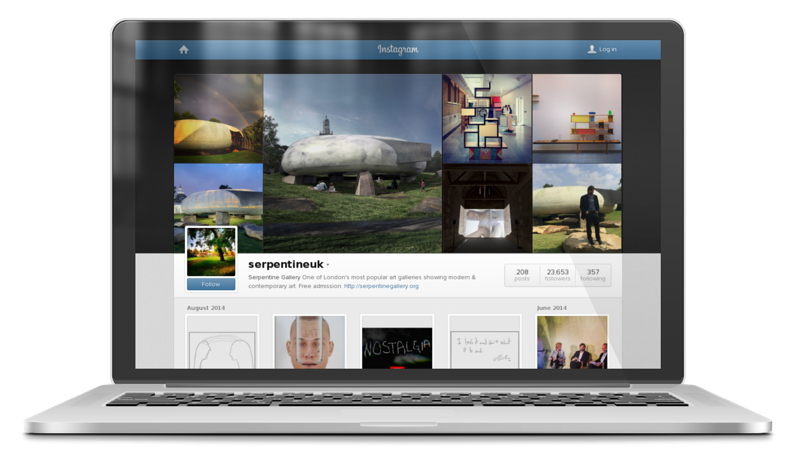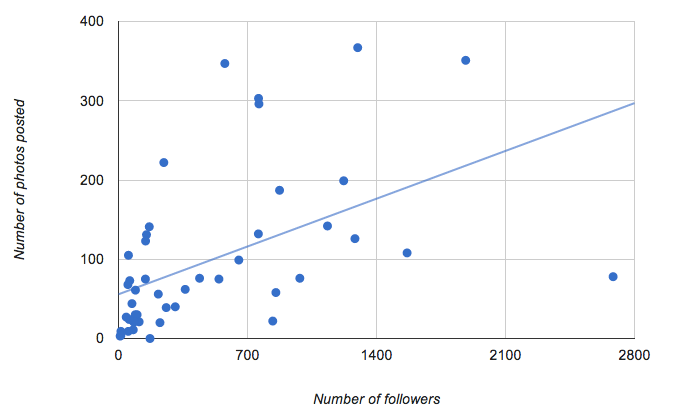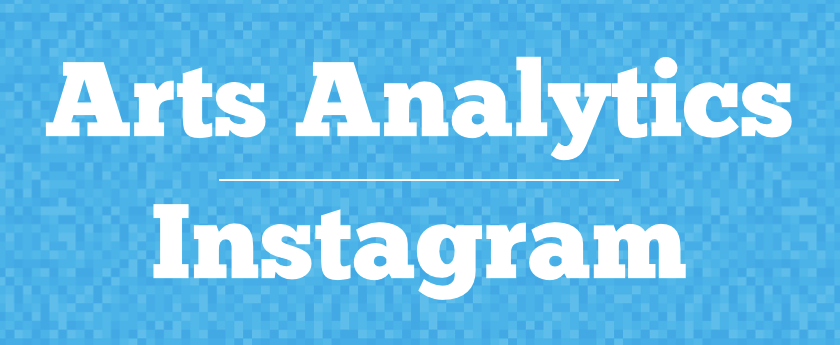Instagram has taken off like crazy, built by a small team and acquired by Facebook for big bucks. It’s also a platform that ticks the boxes of a few very prominent trends – mobile-first, visual-led and driven by the creativity of its users.
For this post in the Arts Analytics Series I wanted to see:
- which arts organisations have been experimenting with it,
- who’s using it the most; and
- who’s getting the most traction.
Taking my sample group of 100 organisations, I looked up their Instagram accounts and then pulled out their key stats into a spreadsheet. Firstly, though…
How to find Instagram accounts
This gets a sub-heading of its own, because searching for accounts on Instagram is a pain. To find the accounts I tried these three things:
- Searching on Iconosquare – a third party Instagram tool.
- Googling the name of the organisation plus Instagram.
- Looking on the organisation’s website. Sometimes there are social media logos in the footer (or elsewhere). This was a last resort, but it did work in a couple of instances.
If I missed any accounts then please let me know. I think I did pretty well, but reckon one or two might’ve passed me by (and please make sure you make your account easy to find).
Here’s the data, sorted by the number of followers:
Data was collected on 18 August 2014.
Findings
- 55 of the 100 organisations in my sample group have set up Instagram accounts.
- The ratio of followers to following doesn’t seem to indicate anything at all.
- There’s some correlation between the number of followers and the number of photos posted, but it’s a bit sketchy.
- Galleries seem to be disproportionately popular at the moment.

The organisations with the most followers
- Serpentine Gallery (23,442)
- Royal Opera House (17,583)
- Barbican Centre (16,688)
- English National Ballet (10,893)
- The Photographers’ Gallery (8,456)
Why are they so popular? Well, it’s not going to be down to one single thing, but here are some factors:
- They put the effort in. They’ve each posted quite a few times (although ENB not so much) and their pics are interesting and attractive.
- Comparative levels of brand recognition. The Barbican, ROH and ENB are often towards the top of these lists and I’d suspect that has something to do with it.
- They all have other healthy social media accounts that they can cross-promote from.
- The Royal Opera House do a great job of tagging their photos with tags that people on Instagram actually use. See http://instagram.com/p/r4qM8BhDVD/. Are #foodgasm and #foodporn very ROH-like terms? Maybe not. Do people use them on Instagram? Heck yeah.
- In the case of TPG, it won’t have hurt that (a) they’re a photo-centric organisations and that (b) they did an Instagram-themed event at the weekend, although my figures were collected a little before that took place.
The Photographers’ Gallery has also posted the most photos by far quite a long way. Speaking of which…
The five most snap-happy organisations
- The Photographers’ Gallery (693)
- Royal Opera House (471)
- Fact (Foundation For Art & Creative Technology) (367)
- South London Gallery (351)
- Theatre Royal Stratford East (347)
Although posting a lot of photos doesn’t necessarily translate into lots of followers there does seem to be some sort of correlation. Here’s a graph of followers v photos posted:

I took out the orgs with more than 3,000 followers because they made the graph hard to read.
There’s a bit of a trend there, but we’re working with limited data and it’s fairly erratic. I’d say it’s a signal, but not a strong one. I guess the more photos you post, the more often you can cross-promote across other social media accounts and the more ‘alive’ and worth following that account is. The content still has to be good.
Beyond that, the discovery mechanisms in Instagram are currently pretty limited. For instance, just because you’re posting lots of photos and they’re getting a lot of likes or comments, doesn’t mean that friends of your followers will see that. Not in the way that retweets will get you more visibility on Twitter or interactions will increase your chances of showing up in news feeds on Facebook (although that’s becoming a fond memory anyway).
A couple of other observations:
- A couple of accounts – Headlong Theatre and Theatre By The Lake – are being kept private at the moment.
- Props to the Craft Council. They racked up 171 followers without posting a single photo. Several orgs have posted more than 100 times and still have fewer followers than that.
Thoughts and conclusions
It’s early days for Instagram and, honestly, it’s probably too early to draw too many conclusions about anything much from the figures I’ve collected. If you’re looking to find what’s ‘normal’ then I don’t think anything particularly coherent has emerged.
However, it’s interesting to see which organisations have started figuring out this relatively new platform.
It’ll be interesting to see what happens with organisations’ use of Flickr from this point. It’s been the platform of choice for storing photos for some time, but it also feels like a less popular destination these days. The two services have very different sets of functionality and so lend themselves to different purposes, so I’ll be watching with mild interest.
By the way, I wasn’t able to look at the number of comments and likes on photos. If anyone comes across a way to do that then let me know. It’d be interesting to see what sort of thing is getting the most traction and to marry those figures up with some of the numbers I’ve collected.
A couple of tips:
- If you have an Instagram account then please include the name of your organisation in your profile to make you more findable. If you’ve got a blog then maybe mention it there too – it’ll help make your account easier to find.
- Use #tags. They seem to be one of the principal discovery mechanisms at the moment. Don’t go too nuts though – at least keep them relevant.
Anyone else got some tips to throw in?
By the way, someone requested that I cover Instagram as part of the Arts Analytics series. If you’ve got any requests then just let me know. If I can accommodate it then I will.
[hypha_alert style=”green”] Please take a second to share this post if you liked it. [/hypha_alert]
[hypha_alert style=”white”] See the rest of the posts in the Arts Analytics series. [/hypha_alert]

This is really interesting Chris. We were conducting our own research in a similar style. Interesting to note that galleries are ahead of the curve.
I’d add in that they’ve recently improved the discoverability on Instagram as the ‘Explore’ screen is now biased towards pictures that people you follow like (http://mashable.com/2014/04/23/instagram-personalizes-explore/).
My top tip is to set up ifttt.com to send you a daily email with all the post geo-tagged in a radius around your building, then you can like them, comment or follow as you see fit. People then tend to follow you back.
That’s a superb tip, cheers!
Really interesting, thanks Chris, and nice to see who’s setting a good example. That’s not a BRB instagram account by the way, that’s a company in Alabama.
Ha! Now there’s a classic mistake if ever I saw one. Cheers for pointing it out, I’ve updated the post and the spreadsheet.